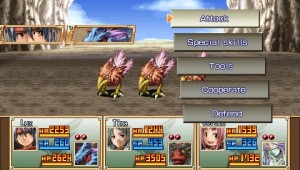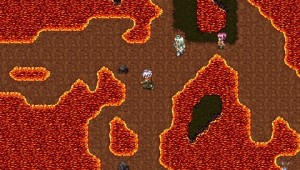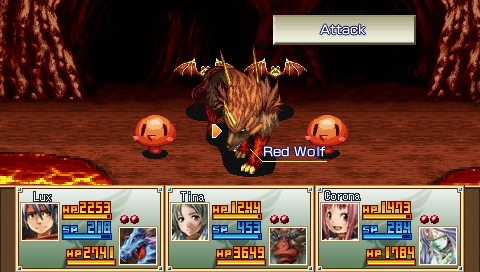Mystic Chronicles Review
It may come as a surprise to some of you, but the PSP is still receiving a slow trickle of releases, even if they are of the digital nature, rather than in physical form. Most of these releases take the form of JRPGs, which is good news for fans of the genre, and most of them can also be played on the PS Vita, which is further good news for those looking for an excuse to dust off their Sony handheld. Mystic Chronicles, which comes from developer Kemco, and publisher Natsume, was originally released on iOS in 2012 under the title Fantasy Chronicles, but here sees a re-release on Sony’s devices. Mystic Chronicles harks back to classic RPG tropes of the early 1990s, but is it worth exploring in the present day?
The main protagonist in Mystic Chronicles is a young male called Lux, who, in classic RPG fashion, has a mysterious past, which revisits him in the form of nightmares and flashbacks. Lux lives in Selka Village under the care of Ohma, his adoptive grandmother, and he seeks to join the Holos Guild, an organisation devoted to the continuation and improvement of world peace, following a devastating war in which beings known as Guardian Beasts saved the world from the encroachment of a group known as the Dark Clan. Within the opening act of the game, Lux discovers that he is a Covenanter, a human with the ability to call on the powers of the Guardian Beasts, and does so in order for them to aid him on his quest to save the world from a new, emerging threat.
Mystic Chronicles mixes up the classic RPG progression in a fairly unique way, with Lux and later, his allies, being given both Missions and Quests. Missions exist to drive the narrative forward, and are unlocked naturally as the story is played through. Quests, on the other hand, are optional missions, often consisting of killing a specific number of a certain kind of monsters. Once these Quests are completed and returned to a Guild, they dish out rewards of either money, items, or both. The game is good at keeping players updated on the status of their Quests, with prompts appearing mid-battle if the death of a particular enemy allows for completion of an active Quest. These Quests are also a clever way of hiding otherwise extensive grinding, and give you an excuse for spending a number of hours wandering the wilderness, looking for enemies to fight. They’re also a good reason to pick up the game for twenty minutes or so, as each battle feels worthwhile, when there’s a potential reward waiting for you next time you happen to visit a town.
 While dungeons and other areas are featured as typical top-down areas to explore, find treasure and battle foes, towns are instead presented as static images, with a selection of particular buildings to visit. Most towns have the same selection of buildings, such as Inns, Guilds and Workshops, and arriving at a new town often gives the player a chance to unlock new Quests and discover more information about the world. Another incentive for visiting different towns lies in the Workshops, as it is here that the player is given access to additional Training Books, which are vital for increasing the strength of your party’s weapons and armor.
While dungeons and other areas are featured as typical top-down areas to explore, find treasure and battle foes, towns are instead presented as static images, with a selection of particular buildings to visit. Most towns have the same selection of buildings, such as Inns, Guilds and Workshops, and arriving at a new town often gives the player a chance to unlock new Quests and discover more information about the world. Another incentive for visiting different towns lies in the Workshops, as it is here that the player is given access to additional Training Books, which are vital for increasing the strength of your party’s weapons and armor.
These Training Books are the basis for one of the more unique aspects of Mystic Chronicles’ gameplay, in the fact that rather than finding new and more powerful weapons and equipment, Lux and his party instead focus on upgrading the weapons currently in their possession. Starting at a base model, each piece of equipment can be upgraded in stages to a +5 version, with branching options appearing at the +3 level. At this point, players can decide to continue improving the weapon in its current form, or change it to the base model of an ultimately more powerful or more specialised (in terms of elemental effects) item. These upgrades are performed using various materials which can be found in the world, either through defeating enemies, or finding material deposits in dungeons and exploring the land. Though stronger base models can occasionally be found in the world, or can be bought at workshops, upgrading them is the only real way to get the strongest weapons available, and it’s a quite unique way of managing character progression throughout the game.
 Once in combat, Mystic Chronicles takes on a look familiar to those who have played the earlier Dragon Quest games, with enemy models appearing in various rows, and party members appearing as icons at the bottom of the screen, with HP and SP meters alongside their image. Once Guardian Beasts are unlocked via the story, their image appears alongside the party member that they are assigned to, and aid the party in both dishing out and absorbing damage. Though Guardian Beasts can’t be directly controlled, they can be assigned one of three tactics to focus on, be it Attack, Protect or Restore. Guardian Beasts level up along with party members, and can also be given equipment and items as stat boosts. Though Guardian Beasts can’t use this equipment in the same way as party members, it can unlock extra moves for the Beasts to use during combat. One particularly enjoyable inclusion in the battle system is the presence of an Auto mode, which is activated by pressing the Square button. When activated, the game will control actions of both party members and Guardian Beasts, which proves particularly useful when grinding against low-level enemies for experience, as you don’t have to input every individual command.
Once in combat, Mystic Chronicles takes on a look familiar to those who have played the earlier Dragon Quest games, with enemy models appearing in various rows, and party members appearing as icons at the bottom of the screen, with HP and SP meters alongside their image. Once Guardian Beasts are unlocked via the story, their image appears alongside the party member that they are assigned to, and aid the party in both dishing out and absorbing damage. Though Guardian Beasts can’t be directly controlled, they can be assigned one of three tactics to focus on, be it Attack, Protect or Restore. Guardian Beasts level up along with party members, and can also be given equipment and items as stat boosts. Though Guardian Beasts can’t use this equipment in the same way as party members, it can unlock extra moves for the Beasts to use during combat. One particularly enjoyable inclusion in the battle system is the presence of an Auto mode, which is activated by pressing the Square button. When activated, the game will control actions of both party members and Guardian Beasts, which proves particularly useful when grinding against low-level enemies for experience, as you don’t have to input every individual command.
Though Mystic Chronicles is a fairly solid RPG in the way of gameplay, it suffers to quite an extent when it comes to presentation and input. While the visuals are an obvious throwback to classic RPGs, this leaves some of the environments and areas looking quite mundane, despite their variation, and the menu screens are particularly bland, appearing as a staid brown colour which isn’t especially pleasing to the eye. What’s more, the game is rife with spelling errors, both in terms of battle status updates and conversations, with ‘critial hit’ and a ‘paniced’ status being two of the most commonly experience examples. The game also obviously isn’t designed for the analogue stick that is present on both the PSP and PS Vita, as it is far too sensitive within menu and town screens, almost to the point of uselessness.
So, is Mystic Chronicles worth digging out your PSP, or dusting off your PS Vita, for? Yes and no. On a basic level, it’s a solid RPG, and offers up a decent experience for those looking to grind on the go. On the other hand, it doesn’t offer up a whole lot of difference from what else is available on the market, aside from its fairly unique weapon upgrade system, and its issues in terms of presentation certainly doesn’t earn it any favours. Still, if you are desperate for a new RPG experience, you could do worse than Mystic Chronicles, so long as you don’t expect something that will shatter your expectations of what an RPG could be. It’s an enjoyable experience, but not something you’ll be rushing out to tell all your friends about.
About This Post
